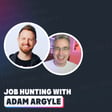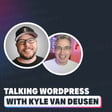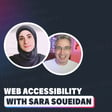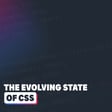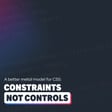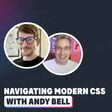Become a Creator today!Start creating today - Share your story with the world!
Start for free
00:00:00
00:00:01

Keeping up momentum with self-paced learning
Online courses are awesome, but it’s really easy to get started with one only to let it drop by the way side after completing 20% of it, or actually finish one, but not feel like you learned as much as you were hoping to.
In this episode, I explore some tips on how to get the most from online courses, and how to help make sure you actually get all the way to through them as well!
What I’ve been up to this week:
- I asked people to make this simple layout and was surprised by the results
- A simple approach to layouts when going from design to code
- :nth-child has a super power most people don’t know about
Other awesome stuff around the web:
Find me elsewhere on the web:
Transcript
Introduction to 'General Musings' Podcast
00:00:00
Speaker
Hello my front-end friends, and welcome to my podcast General Musings. My name is Kevin, and this podcast is the audio version of my weekly Sunday newsletter, where I talk about whatever is front of mind in any given week, usually in some way or another that is related to front-end development, while also sharing fun sites and resources that I come across during the week, and talk a little bit about some of the content that I've created as well.
Strategies for Successful Online Learning
00:00:24
Speaker
This week I'm going to be sharing some strategies on how we can be successful with online self-paced learning because it's really easy to say get an online course and get about 20-25% of the way through it, slowly lose momentum and just let it drop off to the side and never actually complete it, or to maybe even make it to the end of it but not feel like you've actually learned as much as you were hoping to.
00:00:46
Speaker
And this follows up a little bit from last week's discussion where I was talking about how when we follow tutorials, it's easy to fall into the trap of thinking we know how to do something when all we actually have is just a general understanding of it. And a big part of that was talking about how it's important to not just follow along with tutorials, but to take an active approach to learning instead of just sitting back and being passive.
00:01:12
Speaker
And of course, sitting back and being passive also includes just having the tutorial up there on your screen and following it line by line blindly writing in the code that they're telling you to write without actually doing things on your own and trying to figure out things on your own.
The Importance of Independent Problem-Solving
00:01:26
Speaker
So it's really important
00:01:27
Speaker
that you don't just sit back and that you try and do things more independently looking at what's going on in the course then trying to solve some of the problems on your own or taking what you're learning in the course and trying to implement it into other projects or other things that you might be working on that's definitely like the most important step that you can do and it's a big part of why people get into what we call tutorial hell just because they're actively following tutorials not actively learning
00:01:51
Speaker
by you know independently working and actively working on different things but there's a lot more that you can do to help yourself be successful especially if you're doing longer courses but with any sort of online learning or any type of self-paced learning so this week i want to share with you tips around that idea but mostly around the idea of keeping the momentum going because as i mentioned earlier it's really easy to lose that momentum when you're doing online courses or
00:02:14
Speaker
following along with things and there's different reasons that can happen but there's a lot of strategies that we can put in place to help make it a lot easier to keep on going with things and then next week I'm going to sort of wrap up this miniseries on online learning and making the most of self-paced learning with one final tip that I want to put a lot of emphasis on so that's going to get its own episode.
00:02:35
Speaker
And just before we dive into the tips themselves, I just want to mention that I'm going to be framing all of this in terms of doing an online course. But everything here would apply to any sort of self-paced
Time Management for Online Courses
00:02:46
Speaker
learning. So whether you're doing a more guided course or whether you're sort of piecemealing things together on your own from tutorials that you're finding online, all of these ideas would work no matter what.
00:02:55
Speaker
And my very first sort of tip is to realize how long it's going to take you to complete an online course. Or if you're just watching a single video, how long will it take to complete that single course? And as an example, let's talk about doing you find a course online, you really want to do it. And it's a video based course that has 10 hours of content. How long do you think that would actually take you to complete?
00:03:18
Speaker
Now, if we go back to what I was talking about last week, where we're actively learning, which means not just copying the code as the instructors writing it, it obviously does mean that it would take more than 10 hours to do. But how much longer than that 10 hours do you think it would take? Because at first glance, a two hour course would seem to be something that if you really put your head down and wanted to, you could get through in like two full days of learning, right?
00:03:41
Speaker
In reality, personally, I think it should take you about four to six times as long as the course to actually be able to complete that course. And if we're talking about a 10 hour course, that's becoming 40 to 60 hours. That's like a full week of eight hour days or a week and a half, maybe even two weeks of eight hour days to get through 10 hours of content.
00:04:02
Speaker
For some people, instead of four to six times longer, it could be three times longer or it could even be as much as ten times longer. It depends a little bit on how familiar you are with the content, the ways that you like to learn, just your general attitude towards learning how fast you like to go through content and all of that. But I think if you're doing it any faster than three to four times the total length of the course, that means that you're taking shortcuts and most importantly, you're not making the most out of the course.
00:04:29
Speaker
And if you think four to six times as long as the content itself is long, I've even had someone tell me that one time when I was talking about this concept that they actually take if they see a one hour YouTube video, they're going to take one full day to put aside to watch that tutorial and learn from it.
00:04:46
Speaker
And that's just a single one-off tutorial that they're trying to follow that's one hour long. So this idea isn't ridiculous. It might seem like it at first, especially if you're the type that just likes following along with courses instead of trying to actively learn. But if we're following that advice that I was talking about last week, where you're trying to do a lot of practice, you're learning something, you're trying it again, you're redoing parts of the lesson, but without the tutorials, you're doing all of that, it's going to take a long time to get through all of that
Enhancing Learning Retention with Breaks
00:05:12
Speaker
content. And that's really normal.
00:05:14
Speaker
and it's really important that you acknowledge that before you start the course and that's really like the first step that you have to do is make that acknowledgement because if you think a course is going to take you 13 hours because it's a 10 hour long course and you know you have to pause the video and a few other things and it's taking you longer than you expect it to that can be really demotivating and as soon as we lose our motivation for doing a course it's going to fall by the wayside you start getting frustrated you don't go back to it as often and it just vanishes and you never complete it
00:05:41
Speaker
so please make sure you're aware of how long something might take before you go into it because if not then you just you probably will never actually finish it and on that front of taking a long time one thing that can actually make you take longer is my second tip which is to take a lot of breaks
00:05:58
Speaker
going through like a four-hour learning session or even an eight-hour learning session all at once might make you feel like you're making a lot of progress. You're going through so much content it feels really good but there's no way that you're retaining all of that. I've
Scheduling and Consistency in Learning
00:06:12
Speaker
been there, I've done this. I know how it feels and it feels like you're doing so great and by taking breaks it's interrupting that stream and it's really easy to convince ourselves like oh I just need to finish this one more line or this one more challenge or this lesson or whatever. It's always easy to go to that one next one but it's
00:06:28
Speaker
So important to take regular breaks and this is why things like Pomodoro timers are so popular right because they sort of get us on the schedule of You know working on content and then taking breaks and then going back into the content and it just ensures that you're doing it at regular intervals and
00:06:44
Speaker
And as much as it can feel like it's breaking the flow as you're going through things, it actually makes for much more effective learning. There are so many studies out there that show that consistently taking breaks leads to much more effective learning sessions. Not only that though, I also recommend not doing too much in one sitting or like one session, even if that one session is broken up with breaks throughout.
00:07:08
Speaker
and even in my own courses i most of them i try putting messages in the course going you know what this would be a really good time to take a break and sort of just reflect on what we've learned up until now because when you do a lot of new content and you're just if you're trying to get through lots of content you're not absorbing all of that you need to take time to be able to just absorb by you doing something else right completely different
00:07:31
Speaker
So take a break for the day, come back to it the next day. Anybody who's been working knows that short breaks are really good at finding solutions, but it's the same thing when you're studying breaking away from the content. Maybe you take the break after a certain lesson, you take your short break, then you come back and you practice. So you're sort of breaking things up a little bit. But just taking breaks, however you're going to do it, is really, really important to do.
00:07:52
Speaker
And that the taking breaks thing is sort of like scheduling things out on the short term. But another thing that I actually do recommend or my next tip here is to schedule learning time for yourself on your calendar. And I'll be the first one to admit this is really hard for me to stick with. But when I do it and I do stick with it, it's super effective.
00:08:11
Speaker
And also the busier you are, the more important this is. If you're just a student, you're home all day long and you just have all day to learn, of course scheduling sometimes can help you not avoid taking those extended video game breaks or something like that. But if you're living a busy life, maybe you're working a full-time job and you have a family, your time is precious and it's easy to let things slip through the cracks because you have other priorities.
00:08:33
Speaker
by setting aside time on your actual calendar and sticking to those times because that's that's always the hard part it's easy to put it on your calendar it's harder to be consistent with it but once you get into a bit of a rhythm with it a few times it becomes a lot easier and that just obviously helps things become much more consistent
00:08:50
Speaker
One of the biggest problems we run into when we're doing self-paced learning, you're doing that course online or whatever, is on-plan breaks, right? You often, it's always the story, you start strong, you're doing tons of stuff early on, then you do a little bit less and a little bit less, and then you take a couple of days and then you go back to it, but not for as long as you had been doing before, and then eventually you just never go back to the course again. I've done this, I know what it's like. And this happens because we're doing too much at the beginning, because we're excited, you want to learn something new, and then it just sort of fades off.
00:09:19
Speaker
If you have it on your calendar in realistic time blocks at the beginning you won't be doing too much and then as long as you're staying consistent with it and you're not taking these unplanned breaks it's going to keep on rolling and by having it on your calendar as this time block that you know you've committed to that then it's going to be even easier to stay committed to it.
00:09:37
Speaker
And when you have limited time, this is just even that much more important.
Setting Realistic Learning Goals
00:09:41
Speaker
And my most important thing that I can mention here is just be realistic with how much time you can actually commit to something. Because as I said just before, it's really easy to be really excited and want to like dive in and spend lots of time on this new thing that you're learning about.
00:09:55
Speaker
And so maybe you're going to go on your schedule and you're going to put a ton of time because yes, I'm going to get through this course really fast. I'm just going to block off these big time blocks. I think I can squeeze all this time in there. But if that's not realistic to your schedule and not something that you can realistically do week in and week out, then it's not a good idea.
00:10:12
Speaker
And when I talk about being realistic with how much time you're setting aside, this doesn't only mean blocking off too much time, but I also mean by blocking off realistic periods of time when you'll actually get this work done. I know if you're working full time and you have kids, you might have heard some productivity gurus talking about how early morning is the best time to get anything done before anyone else is awake because you have no distractions. So you start blocking off like an hour and a half starting at 4.30 in the morning before your kids wake up,
00:10:38
Speaker
or you know that you're the type that doesn't want to get up early. Instead, you start blocking off time late at night when you normally be watching Netflix or something like that. But for those early time blocks, unless you're already an early riser, it's going to be really hard to stick with that. Alternatively, if you do them too late in the day, it's going to be really hard to continue learning just because you're tired at the end of the day and you want to lie on the couch and you want to unwind a little bit.
00:11:06
Speaker
I also know this because I've done both of these. The early early morning thing can be really hard because that means you probably should be going to bed before your kids are even if you want to get enough sleep which does not sound appealing to most people. Usually you want that downtime after your kids are asleep and then of course when it is your downtime after your kids are asleep you don't really feel like learning something because you finally have some time to yourself to sort of chill out a little bit.
00:11:29
Speaker
In my opinion, the best thing you can do is be extremely realistic from the get go, even if that means scheduling in shorter blocks than you think would be effective. In my opinion, it's better to schedule 30 minute blocks three times a week at your lunch break than it is to schedule 430 a.m. learning blocks that you're going to stop doing after four days.
00:11:50
Speaker
Now, no matter what you do, if you've never done this before, you will have to carve out time from things that you're normally doing. But that doesn't mean you should be sacrificing your sleep or that you should be like sacrificing time with your family or anything
Course Recommendation: 'Practical Accessibility'
00:12:03
Speaker
like that. I guarantee you, you can find times in your schedule if you're really committed to learning where you can take out some things and stay realistic about it while you're doing it. Because we want to set ourselves up for success. So plan something that is sustainable for you.
00:12:17
Speaker
And now moving on from there to the other awesome stuff from around the web section of this podcast, but staying on the topic of online courses and self-paced learning, Sarah Suedan has recently launched her course Practical Accessibility. And as a little bonus with this, if you're watching this episode the day it comes out, she is offering 25% off from it through the end of this weekend. I purchased this course when she did an early access presale quite a while back, so I can tell you it's a very high quality course from an expert in the field.
00:12:46
Speaker
Accessibility is one of those topics that can definitely be confusing at times and often seems like there's a lack of good resources and Sarah did a fantastic job with this course. She looks at the big picture things of accessibility with ARIA and screen readers and other topics like that but then she also looks into things like how we can do some testing of course with screen readers and through your keyboard and the different methods there
00:13:08
Speaker
and also dives into common components and how we can build them in accessible ways. You get some practical, let's build this together type advice and a case study and she has a toolkit and there's a whole bunch of very good stuff in there. This isn't an affiliate deal or it's not a sponsorship or anything like that. I just think it's a really high quality course and it's on a topic that needs a lot more attention.
Kevin's Recent Projects and Challenges
00:13:28
Speaker
And now I can move on to what I've been up to this week, which as usual, I've had two longer form videos. The first one I did was taking a look at how we can approach creating a layout when we're starting with a design file, whether it's a Figma file, a JPEG, Photoshop file, anything like that.
00:13:45
Speaker
and go into the code but the purpose of the video isn't let's take this design and code it, it's more about the thought process and sort of the steps I take when breaking down a layout but also in much more of a beginner friendly way. So sort of taking what I often do just in my own head but doing it actually on the screen so we can sort of slow things down and make it a lot easier to code once we get to that step.
00:14:06
Speaker
The second video that I did this week was actually from a challenge that I did in my Discord community, where I asked the community to create a layout based on a JPEG, speaking of going from static design into functional website. And it ended up with almost 100 submissions, which is kind of crazy. And there was a very specific thing that I wanted to look for.
00:14:27
Speaker
in the layout and sort of a difference at one part of it and how people would approach that. There was people that used Flexbox and Grid and a mix of Flexbox and Grid and it was really interesting to see all the different approaches and what I wanted to do is look at the strengths and the weaknesses of the different approaches and see if we could find maybe what the best approach might be and sort of the strengths of some and the trade-offs we might take when we're using different types of approaches.
00:14:52
Speaker
And lastly, of course, I had a short this week as well. In this case, I looked at the nth child syntax or the new addition to the nth child because there's an annoying thing when you're trying to select things in CSS. You might be using nth of type and put a class in there. So you might say have like intro nth of type 2 and you think it's going to select the second element that has that intro class on it. But it actually only selects the intro if it is the second element within the parent.
00:15:19
Speaker
This is definitely one of those things that's hard to try and explain and not look at the code for.
Conclusion and Listener Engagement
00:15:23
Speaker
But basically we now have an nth child syntax. So you can say nth child for of class name, right? And it's going to select the fourth element that has that class on it and you can use any selector you want. So it's really nice to be able to do that now.
00:15:37
Speaker
And speaking of stuff that I've been up to, even though I haven't actually launched one in a little while now since last week and this week and going into next week, I'm talking about courses. I might as well mention that I do have some as some of my courses are free, some of them are paid, but all of them are about helping you get better at CSS.
00:15:55
Speaker
So if you're interested in anything, it goes from beginner all the way to my advanced courses. There's a whole bunch of stuff. So there is a link in the description to my courses page, which then has links to all of them. And in the description, there's also a link to my newsletter if you'd prefer the written version of this podcast. And of course, a link to everything else I've mentioned along the way today as well. Thank you so much for listening. And until next time, don't forget to make your corner of the internet just a little bit more awesome.

